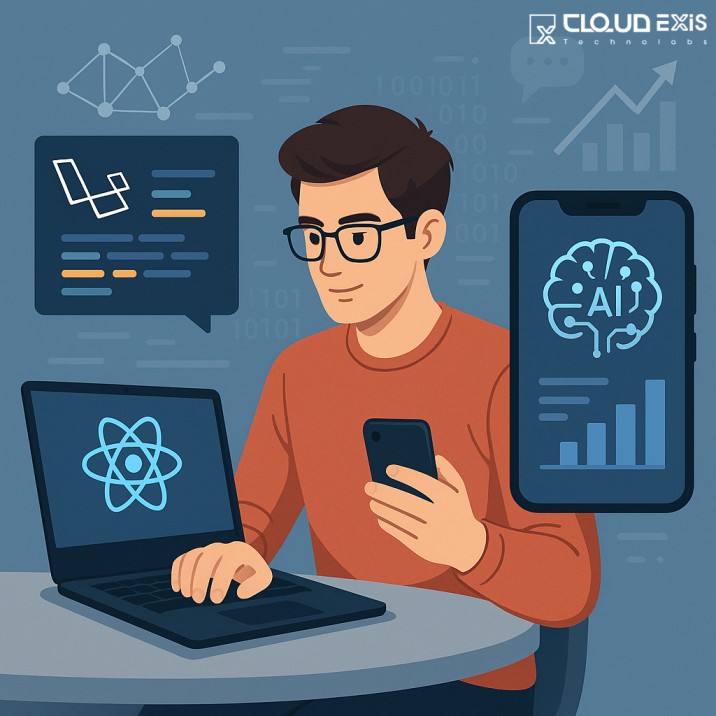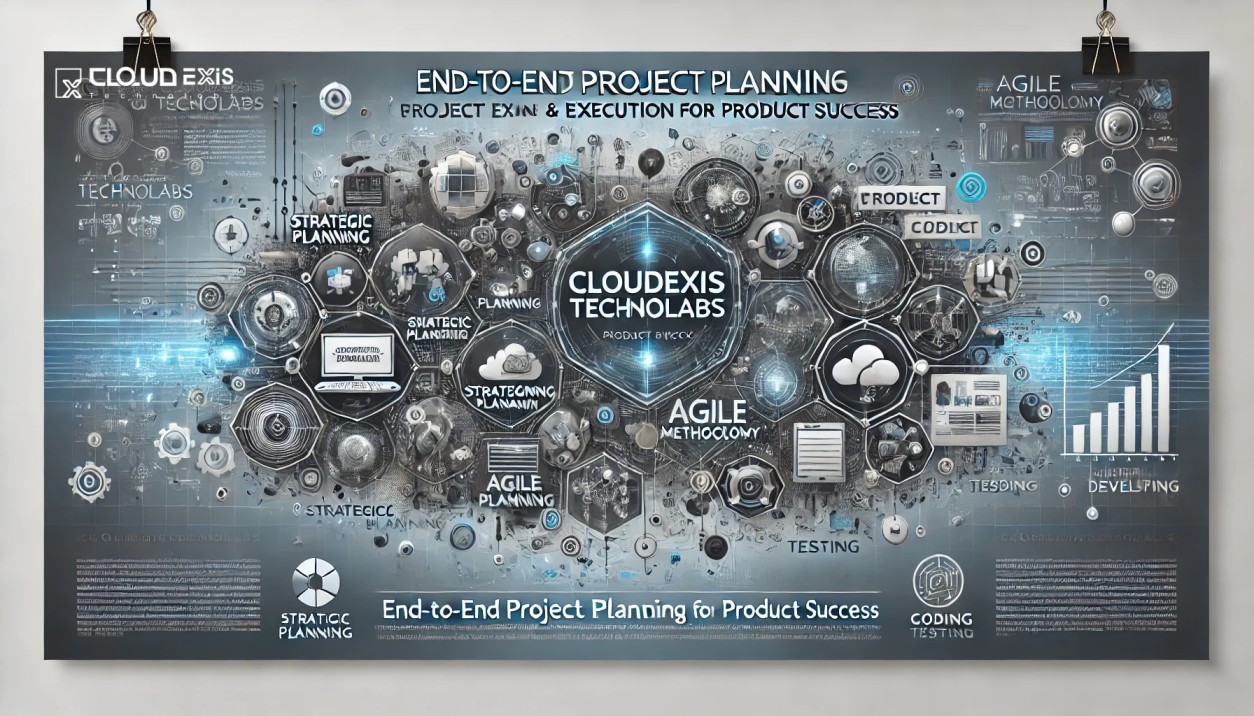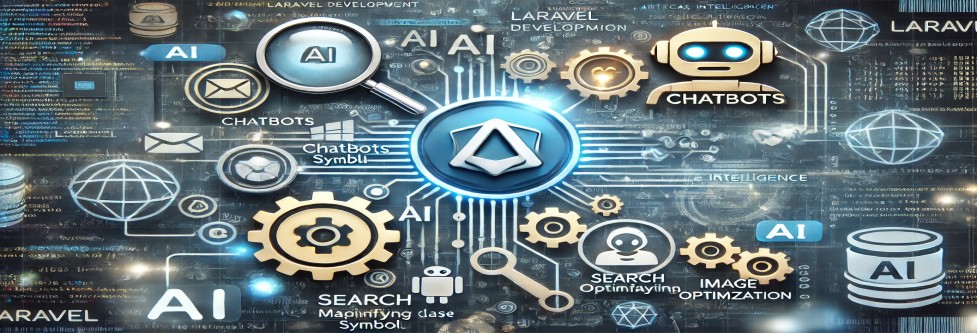Introduction
The world of software development is evolving faster than ever. As businesses race to deliver smarter, faster, and more efficient digital products, full-stack developers find themselves at the forefront of this transformation. The combination of Laravel, React, and Artificial Intelligence (AI) is redefining what it means to build modern, intelligent, and scalable web applications.
In this blog, we’ll explore how this trio. Laravel as the backend framework, React as the front-end powerhouse, and AI as the innovation engine is shaping the future of full-stack AI applications. You’ll also learn what this means for developers, how these technologies integrate, and what trends to watch for in the coming years.
Why Laravel + React is the Perfect Full-Stack Foundation
Before we dive into the AI revolution, let’s understand why Laravel and React are considered a powerful foundation for modern development.
The Power of Laravel
Laravel has earned its reputation as one of the most elegant and developer-friendly PHP frameworks in existence. It simplifies complex backend development through features like:
MVC Architecture: Clean separation of logic, presentation, and data.
Eloquent ORM: Intuitive database interactions using object-relational mapping.
Blade Templates & Artisan CLI: Built-in tools that accelerate productivity.
Authentication, Security, and Queues: Enterprise-grade reliability and scalability.
As web development evolves, Laravel continues to modernize, adapting to microservices, serverless deployments, and API-first architecture. This makes it an ideal choice for developers building scalable backends that need to handle AI-driven operations and real-time data.
The Power of React
On the front-end, React has become synonymous with speed, interactivity, and modularity. Its component-based architecture allows developers to create dynamic, reusable UI elements while maintaining efficiency and clean code. Key advantages include:
Virtual DOM: Ensures optimal rendering and lightning-fast user interfaces.
Hooks and State Management: Simplify complex UI logic and maintain predictable state flow.
Large Ecosystem: Thousands of libraries, community tools, and frameworks like Next.js for server-side rendering.
React’s scalability and performance make it a natural partner for Laravel, allowing teams to craft robust end-to-end applications where the backend handles business logic and APIs while the front-end delivers a seamless, interactive experience.
Why the Pair Works So Well
Combining Laravel and React provides the perfect balance between structured backend logic and dynamic front-end interfaces.
Separation of Concerns: Laravel handles server-side responsibilities; React handles client-side rendering and interactivity.
API Flexibility: Laravel’s REST or GraphQL APIs work smoothly with React’s data-driven components.
Scalability & Modularity: You can scale each part independently, React on CDNs and Laravel via cloud or serverless hosting.
This stack alone sets a strong foundation but when AI enters the equation, it transforms development altogether.
How AI is Revolutionizing Full-Stack Development
AI is no longer just a buzzword. It’s an integral part of how modern systems function. When integrated into full-stack applications, AI extends far beyond chatbots and recommendations; it powers smarter workflows, automation, and predictive user experiences.
Let’s see how.
AI-Driven Development Workflows
AI is now reshaping how developers write, test, and deploy code.
AI Code Assistants: Tools powered by machine learning help generate functions, optimize syntax, and identify vulnerabilities.
Automated Testing: AI can predict potential bugs and generate test cases automatically.
Smart Documentation: AI can summarize complex APIs or codebases, improving onboarding and collaboration.
For Laravel developers, this means faster model generation, controller scaffolding, and database optimization. React developers benefit from AI-assisted design and component generation, cutting down prototyping time dramatically.
AI-Powered Features in Applications
Once deployed, AI transforms how applications behave and interact with users. Examples include:
Personalization Engines: Recommend products, articles, or content based on user behavior.
Predictive Analytics: Forecast trends, user actions, or system loads using machine learning models.
Conversational Interfaces: Chatbots or voice assistants that improve customer engagement.
Automation Workflows: AI models handling data analysis, scheduling, or error detection in the background.
Laravel’s API structure makes it ideal for integrating with external AI services or hosting custom ML models. Meanwhile, React’s component-based front-end can visually represent data patterns, predictions, and intelligent feedback loops in real-time.
Intelligence in the Full-Stack Architecture
In an AI-integrated full-stack environment, intelligence operates at multiple layers:
Backend (Laravel): Handles model training, AI API integrations, and data pipelines.
Frontend (React): Visualizes predictions, offers interactive AI tools (like recommendation widgets).
Infrastructure: Supports serverless execution, job queues, and data streaming for real-time AI response.
The result? Systems that learn, predict, and adapt, reducing human input while improving user satisfaction.
Building Full-Stack AI Applications with Laravel and React
Now that we understand the synergy, let’s explore how to actually build a Laravel React AI development workflow.
1. Architect Your Application
Start by defining clear boundaries:
Laravel: Manages backend logic, database communication, and API endpoints.
React: Handles UI rendering, data display, and user interactions.
AI Layer: Can be a microservice or API connected to Laravel via REST or GraphQL.
For instance, Laravel could expose an /ai/predict endpoint that calls a machine learning service, processes the response, and returns it to React for display.
2. Integrate AI Models
You can integrate AI in two ways:
Hosted AI Services: Use APIs like OpenAI, AWS AI, or Azure Cognitive Services to process data.
Custom Models: Host your own Python-based ML models, accessible via Laravel’s middleware or microservices.
Laravel’s Queues and Scheduler can automate periodic retraining or data processing tasks, while React fetches predictions dynamically to display updated analytics or recommendations.
3. Design the Front-End Experience
React’s strength lies in creating fluid, dynamic experiences. When working with AI data:
Display confidence scores or recommendations using charts and visual cues.
Build reusable “smart components” that react to data changes in real-time.
Use WebSockets or Laravel Echo to push updates directly to the user interface.
This makes applications feel more alive, with instant feedback and adaptive layouts.
4. Manage Data Flow and Performance
A critical success factor for full-stack AI applications is data management. Laravel’s Eloquent ORM allows seamless handling of structured and unstructured data, while caching layers (Redis, Memcached) ensure rapid responses.
For performance:
Optimize API calls and implement pagination or lazy loading.
Use React’s Suspense and memoization to prevent unnecessary re-renders.
Employ Laravel Horizon or Vapor for background AI task management.
Emerging Trends in Full-Stack AI Development
The fusion of Laravel, React, and AI is creating new paradigms for developers. Let’s look at what’s shaping the next generation of applications.
1. Microservices and Modularization
Instead of large monolithic apps, future full-stack systems will adopt microservices. Laravel’s modular structure fits perfectly here, each service can handle a specific function (auth, AI inference, analytics). React front-ends can consume these services through APIs, ensuring scalability and flexibility.
2. Serverless and Cloud-Native Architectures
Developers are moving toward serverless deployments using tools like Laravel Vapor, AWS Lambda, or Google Cloud Run. These environments reduce infrastructure overhead and allow AI services to scale on demand.
3. Real-Time and Event-Driven Applications
With technologies like Laravel Echo and WebSockets, real-time interactions such as live chats, notifications, or collaborative tools are becoming mainstream. Pair this with React’s state management (like Redux or Zustand), and you can build highly responsive apps that process and display AI-driven updates instantly.
4. Headless CMS and API-First Design
Headless architectures decouple content management from front-end rendering. Laravel acts as a headless backend, exposing APIs that React (or even mobile apps) can consume. This pattern works seamlessly with AI integrations where the backend processes intelligence and the front-end visualizes it.
5. AI-Assisted Development and Automation
AI tools now help developers generate components, predict user stories, or even refactor code. Full-stack teams leveraging AI will see dramatic improvements in delivery time, quality, and maintainability.
6. Ethical and Responsible AI
As AI becomes a part of every application, developers must ensure responsible use by avoiding bias, securing user data, and providing transparency in AI-driven decisions. Laravel’s built-in authentication and encryption make it easier to maintain compliance and trust.
Challenges and Best Practices
No technology stack is without challenges. Here’s how to overcome common hurdles in Laravel React AI development.
Challenge 1: Managing Complexity
AI-powered full-stack systems require coordination between multiple disciplines backend, frontend, data science, and DevOps.
Solution: Use modular architecture and maintain clear API contracts between layers. Encourage collaboration through version control and CI/CD pipelines.
Challenge 2: Performance and Latency
AI computations can slow down applications.
Solution: Cache predictions, batch requests, and use Laravel’s queue system for background processing. On the front-end, load components asynchronously using React’s Suspense and lazy loading.
Challenge 3: Security and Privacy
AI relies on sensitive user data.
Solution: Encrypt all data transmissions, implement robust access control in Laravel, and use React only to display non-sensitive insights. Follow data privacy laws like GDPR and CCPA.
Challenge 4: Data Drift and Model Maintenance
AI models lose accuracy over time.
Solution: Use Laravel’s Scheduler to periodically retrain models or refresh APIs. Store user feedback to improve predictions continuously.
Challenge 5: Skill Gaps
Not every developer is well-versed in both AI and full-stack tools.
Solution: Encourage upskilling in Python ML frameworks (for backend AI logic) and React data visualization libraries (like Recharts, D3.js). Cross-training helps teams work fluidly.
What the Future Holds
The fusion of Laravel, React, and AI is only the beginning. Over the next few years, expect to see several exciting shifts:
AI as a Default Layer: Every app from e-commerce to healthcare. will have some form of embedded intelligence.
Low-Code and Auto-Generated Apps: AI will assist in building full-stack applications automatically, reducing manual coding effort.
Edge and Client-Side AI: Lightweight models will run directly in browsers or mobile devices for faster inference and offline capability.
Explainable AI Interfaces: React will play a key role in creating transparent, user-friendly visualizations of AI decisions.
Continuous Learning Systems: Laravel backends will manage real-time data feedback loops, enabling models to evolve based on user behavior.
In short, the future of full-stack development lies in blending robust frameworks like Laravel and React with intelligent automation and data-driven innovation.
Conclusion
The intersection of Laravel, React, and AI represents the next great leap in software engineering. Together, they empower developers to build smarter, faster, and more human-centric applications, ones that learn, adapt, and deliver personalized experiences.
Laravel brings reliability, structure, and backend intelligence.
React delivers dynamic, engaging, and interactive user experiences.
AI transforms ordinary software into intelligent digital ecosystems.
For teams aiming to stay competitive, adopting this stack isn’t optional. It’s essential. The developers and companies that embrace Laravel React AI development today will define the future of full-stack AI applications tomorrow. Contact Us






